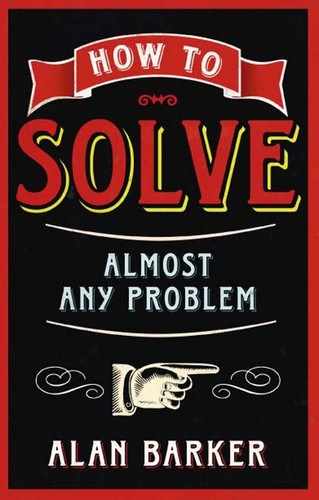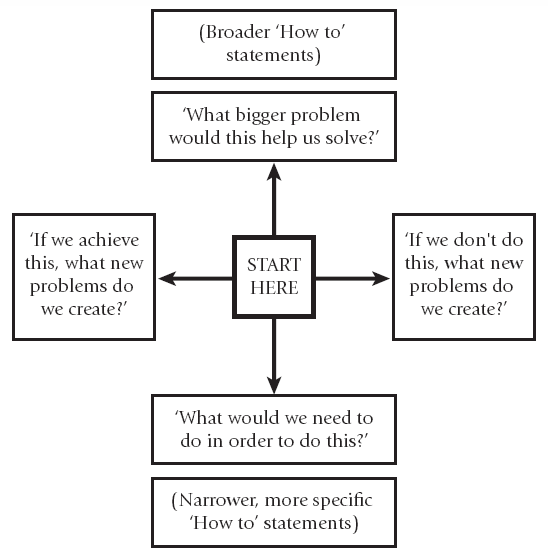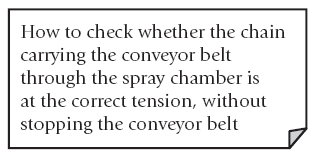Here’s an exercise for you.
You’ll need a blank piece of paper – at least A4 size would be good – and your wallet or purse. Put the blank piece of paper on the table and look at it. Go ahead: look at the paper for at least 15 seconds. It’s blank. Let it be blank. There’s nothing wrong with a blank piece of paper.
Now take everything out of your wallet or purse. Credit cards, photographs, old tickets or cash machine printouts, paper money and coins. You’ll need at least 10 objects.
You’re going to make a design on the blank piece of paper, using the objects from your wallet or purse. You can use only the objects you have, but you don’t have to use all of them. You have three minutes. (Use a stopwatch or your wristwatch to measure the time; you’re not allowed to go past the three-minute mark.)
Don’t read on until you’ve completed the task.
Ready?
Go!
What you have just done is called design thinking.
I’ve just set you a constructed problem. Or rather: you have set yourself a constructed problem, because you’ve chosen to do the task.
Constructed problems: key characteristics
- We create them. They didn’t exist until we thought of them. We are responsible for their existence.
- There is a perceived gap between what is and what could be.
- Solving them is energizing.
- They generate commitment – full ownership.
- Solving them can induce the flow state.
- Focus is on the solution and how to move towards it.
- Method: assembling available materials into workable solutions and checking them against ideal solutions.
Now let’s think more about what it was like to solve this problem.
In this problem, there was nothing wrong: no fault to be put right, nothing to be repaired. (There’s nothing wrong with a blank piece of paper.) And there was no right answer. You were interested in what could be, not what should be.
Were you happy with your design? Most people who do this exercise say that they are quite proud of what they’ve created. That’s an important feature of constructed problems: we usually feel proud of the solutions we create, because we own them.
But if you’re not particularly happy with your design, it’s probably because you feel you could do better. You’d like to try again. That’s also good: ‘back to the drawing board’ is another vital element of design thinking.
(You’re allowed to stop at this point and have another go, if you want to. But stick to the rules: use only the objects you have, and take no more than three minutes. See you shortly.)
Now think about how you were feeling while you were completing the task.
Most people who do this exercise report that they felt energized, fully involved and focused on the task. The task ‘took them out of themselves’. Time passed differently.
They felt committed.
If you felt like this, you were experiencing the flow state we explored in Chapter 4. The task helped you to find that state: it provided you with immediate feedback; the task was time-limited; and you were able to see the results at once. The task also nicely balanced challenge and skill: it was neither too easy nor too difficult, and in fact you were in control of the level of difficulty.
So much for your feelings. What about your actions? My guess is that you did one of two things:
- Perhaps you stared at the paper for a short while and formed some kind of general design in your head. Then you began to use the objects at your disposal to move towards that ‘ideal’ design.
- Or perhaps you started out by playing with the objects: moving them around, combining them in different ways and seeing what happened.
The first approach is the ‘composing’ approach. It’s the equivalent of a composer working at a desk or piano, scoring a piece of music before handing it on to a band or an orchestra to play.
The second approach is the ‘improvising’ approach. It’s like a folk or jazz musician picking up their instrument and creating a piece out of the scales, chords or riffs that emerge.
In fact, you probably did a bit of both: switching from composing to improvising and back again.
Why design thinking isn’t analytical thinking
Constructed problems require a different kind of thinking to presented problems. Rather than finding a fault and removing or repairing it, we identify a goal and find a way to create or achieve it. We move from analytical thinking to design thinking.
Plans: well-structured constructed problems
Plans are well-structured constructed problems. We can analyse the structure of a constructed problem in just the same way that we analyse a presented problem: by looking at initial conditions, goal conditions, operators and constraints:
- Where are we?
- Where do we want to be?
- How could we get there?
- What limits our options?
If we can answer those questions precisely, we have a plan.
Plans: key features
- Problem statement: ‘How to ...’
- There is a gap between what is and what could be (see Figure 8.1).
- Problem well defined: initial conditions, goal conditions, operators and constraints clear.
- Solution: create something new.
- Leading heuristics: ‘how to’; opportunity-led design.
Figure 8.1 The gap
The previous design task is a good example of a plan:
- Clear initial conditions: a blank piece of paper and the contents of your wallet or purse.
- A clear goal: although there was no correct answer, the form of the goal was precise. And the goal was a complete task, not a part of a larger problem.
- Clear operators: the rules were simple, and you were in control. Nobody was interfering with your work; you were completely in charge. You were able to start again if you were dissatisfied with your first solution.
- Clear constraints: you could use only the resources available. And the solution was going to be evaluated only in one way: aesthetically (not for usefulness or accuracy).
How do we create clear goals for constructed problems? After all, constructed problems can never have single correct solutions. Solutions in design thinking are never correct – they can only ever be acceptable or appropriate. The more clearly we can define criteria of acceptability or appropriateness, the clearer our goal will be.
We use plans to create new things: a cake, a cure for cancer, the iPod, the Mona Lisa. The clarity of the goal depends on criteria of acceptability or appropriateness. How good is the cake? Is the patient cured? Do our customers like the new product? Do we have a work of art? The criteria may include definitions that are more or less controversial. Does a cake have to be baked? Does the Mona Lisa count as a work of art?
Plans: what styles to use?

Making plans means using design thinking, so, not surprisingly, the Designer style of problem-solving predominates. We’ll also do well to start by using Explorer.
The five stages of design thinking
Design thinking is too important to be left to the Designers. Any constructed problem, in whatever field, is best solved using the basic protocols of design thinking:
- Express the problem as a ‘how to’ statement.
As usual, the way we express the problem is critically important. And we need to express it in a form that’s conducive to design thinking. We need to define the problem not as something wrong, but as a goal to be achieved.
And the simple way to do that is to frame the problem as a ‘how to’ statement. ‘Our current invoicing system is lousy’ is not a statement conducive to design thinking. ‘How to process invoices more efficiently and effectively’ puts us in the right starting place. - Generate lots of ideas.
We all tend to solve the same problems in the same ways. Those mental models can’t help but assert themselves, especially if they were successful in the past. Design thinking demands new ideas. No matter how obviously correct or successful the old solution may seem, we need to generate new solutions if we want to follow design thinking. And the more the better. Generating more than one possible solution can only be beneficial. (Remember the curse of the right answer!) - Refine ideas and build feasibility.
Steps 1 and 2 are going to generate lots of ideas. At step 3, we need to take a handful of the most promising potential solutions and work them out in more detail. At this stage, our task is to build feasibility: to develop a solution so that it becomes more practicable. We might combine elements from different solutions, or transfer elements from one to another. A good idea is to pilot a solution and see how it works. - Repeat steps 2 and 3.
Design thinking is often iterative. Piloting a solution may show that elements need to be redesigned or thought through afresh. ‘Back to the drawing board’, indeed. A pilot solution may also reveal important aspects of the original problem that were previously hidden. - Pick the winning solution and implement it.
Once we know which solution to carry out, we need to set up the plan to implement it. And guess what? Implementation may throw up new problems requiring more design thinking. So, on it goes.
‘How to’: goal orientation made simple
Goal orientation is the textbook name for working out what we want to create. The simplest mechanism for putting ourselves in goal orientation mode is to create a ‘how to’ statement.
You can do this in two ways:
- You can create it from scratch:
- how to cook the perfect Quiche Lorraine;
- how to create an entertaining corporate conference;
- how to develop a new product.
- You can take a presented problem and transform it into a ‘how to’ statement (as we did at the end of the last chapter). Presented problems, as we know, are expressed as statements of what is wrong. Take any such statement and turn it into a ‘how to’ and the consequences are interesting. For example, ‘my client won’t accept my proposal’ might become ‘how to persuade my client to accept my proposal’.
Something magical happens when you make the transformation. From focusing on what’s wrong, you immediately place the focus of your attention on what you can do. You’re now involved in the problem and, more importantly, you’re committed to doing something.
You probably noticed something else, as soon as you read those two statements. The moment you generate one ‘how to’ statement, others begin to occur to you. Why ‘persuade’? Why not ‘make’ or ‘convince’? And then other ‘how to’ statements begin to follow, thick and fast:
- How to win my client’s confidence.
- How to show the client the benefits of my proposal.
- How to compare my proposal to other proposals on my client’s desk.
- How to arouse my client’s enthusiasm.
- How to make my client feel they’re missing something without my proposal.
- How to break down my client’s resistance.
And so on. ‘How to’ generates multiple possibilities: new ways of thinking about the problem. Some of them will be sub-problems: things you would need to do to achieve the larger goal. Others will be different ways of looking at the problem, including metaphorical or crazy statements that might stimulate more imaginative approaches to the task. Other potential ‘how to’ statements might be:
- functional aspects (design, production, administration, finance ...);
- different points of view (management, technical, customer, political);
- departments affected (functional, divisional, regional);
- reasons for or causes of the problem; or
- chronological stages or process steps in the problem.
‘How to’ is a wonderful tool for unsticking your thinking about a problem.
Of course, generating so many ideas can be alarming. How to make sense of this mess? It’s important that, at some point, you insist on a single, definitive ‘how to’ statement that sums up the problem as you see it. After all, without a defining ‘how to’, you’ll be unable to focus your activities into a coherent plan. But the ‘how to’ that you choose after this period of expansive exploration is likely to be far more interesting and powerful than the ‘how to’ you began with. All the new ‘how to’ statements have allowed you to explore different aspects of the problem, including your feelings about it and what you really want to achieve.
What to do
Unsticking your thinking with sticky notes
One way to develop your ‘how to’ thinking is to use pads of sticky notes. As you generate new ‘how to’ statements, put each one on a new sticky note. As the number of ‘how to’ statements increases, you can begin to move the sticky notes around, helping you to see how they relate to each other.
For example, you might decide to cluster the ‘how to’s into categories. Typical categories might be:
- people
- systems
- processes
- equipment.
Alternatively, you might like to map ‘how to’ statements into networks of relationships, or process diagrams. You could sort them into trees, made up of main ideas and sub-ideas. Often, the principle of organizing the ‘how to’s suggests itself as you are working on the problem.
Using sticky notes gives you the freedom to organize and reorganize your ideas as you go. And it often helps you find yet more ‘how to’ statements!
Shifting perspective: developing ‘how to’ in four directions
You can develop your ‘how to’ powers by changing your perspective. And you can shift perspective in four directions (see Figure 8.2).
Figure 8.2 The four directions
Shift upwards: what larger problem do we solve?
In this shift, assume that the problem is in fact a solution. You can then ask two questions:
- What higher-level problem would it solve?
- What benefits would this solution bring?
These are effectively variants of the same question, but it helps to consider them separately.
For example, suppose the original ‘how to’ statement was:
Assume that the problem is a solution. If you could check the chain in this way, what higher-level problem would you solve?
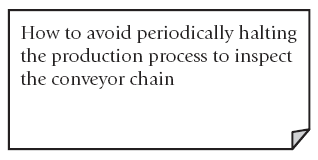
And if you could do that?
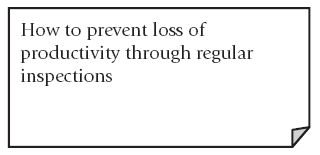
And?
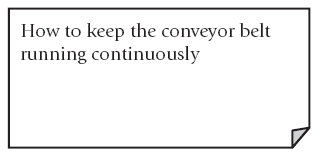
You can ask a similar question by thinking about the benefits of solving the problem. The benefits in this case might include:
- prevention of conveyor slippages due to slack chains;
- prevention of product sprayed wrongly;
- reduced repair costs to the conveyor;
leading to these new ‘how to’ statements:
- how to keep the conveyor running at a constant speed through the spraying unit;
- how to ensure that all products are sprayed consistently;
- how to reduce repair costs to the conveyor.
In all cases, the new ‘how to’ statements are broader, more strategic problems. By shifting your perspective on the problem, you’ve liberated yourself from ‘tunnel vision’: you’re no longer focusing on a specific problem but seeing it potentially as a symptom of a larger problem. By addressing the larger problem, you may be able to solve the original problem and others at the same time.
Shift downwards: how do we achieve this?
This shift, unsurprisingly, takes you in the opposite direction. Instead of assuming that the problem is a solution, ask what you’d need to do in order to achieve the solution.
Suppose the original ‘how to’ is:
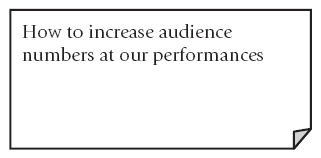
Ask: ‘What would we need to do in order to increase audience numbers?’ Potential answers might include:
Each of these new ideas can be broken down further: publicity would include posters, press, media, e-marketing, viral marketing, and so on; finding new audiences might involve contacting schools and colleges, community groups or different age groups; making performances more attractive might include reviewing production policy, front-of-house arrangements, and so on.
In all cases, the original problem is being broken down into more specific, tactical ‘how to’ statements. Each one is potentially part of a strategic plan to tackle the original problem.
Shifting downwards is potentially the most obvious way to create a plan of action. But there are other perspective shifts and they, too, can be useful.
Shift sideways: if we don’t do this, what problems do we face?
In this shift, consider the consequences of not doing what you’re thinking about. What problems would you face – new or already existing?
For example, suppose your original problem were:
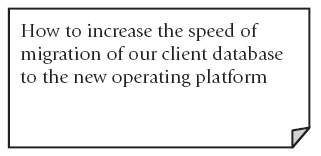
What if you couldn’t migrate your client information more quickly to the new operating platform? What problems, new or existing, would you face? Among the possible problems, you might include:
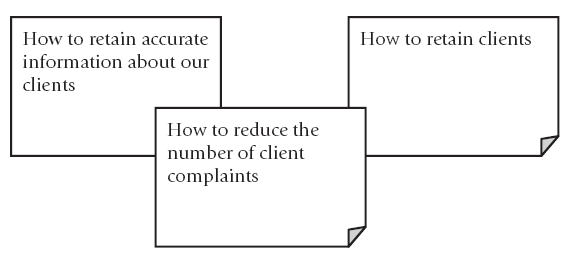
These new ideas are potentially extremely useful in developing contingency or protective measures to make your plan more robust.
Shift sideways: if we achieve this, what new problems do we create?
All plans will have consequences. Some of them will be undesirable. (Remember wicked problems in the last chapter?) By shifting perspective in this direction, you may be able to foresee some of those problems and plan to manage or avoid them.
For example, suppose your original ‘how to’ is:
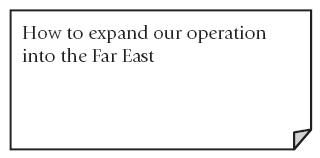
However attractive it might be to access the huge and booming markets of Asia, solving this problem might generate all sorts of new problems, such as:

Once again, the new ideas you generate by shifting perspective help you to make your plans more robust.
Focusing your attention systematically in this way will help you to deepen your understanding of the problem and develop more thorough plans.
The pleasures and perils of planning
Planning, they say, is the process of preparing, making and managing change. Having decided what to do (which ‘how to’ you are going to pursue), the next step is to plan a route from where you are to where you want to be – from initial conditions to goal conditions. The plan you create is the set of operators that will help you achieve your chosen solution.
And yet, we all know that plans sometimes fall apart disastrously. Why? And what can we learn from all the plans that go wrong?
The traditional advice: plan backwards
When thinking about a plan of action it’s most natural, in the words of Lewis Carroll, to ‘begin at the beginning and go on ‘till you come to the end, then stop’. And, if you’ve read project management textbooks, you’ll know that you need to establish ‘milestones’ – places you need to reach by a certain point if you’re to stay on track.
The advantage of planning backwards is that you start with the goal in mind. With the success of your goal clearly in focus, you can then map out the actions needed to get there, and the milestones you will need to cross on your way.
Waterfall planning
Wise project-planning consultants tell us that project planning is itself always subject to change. Trevor Young – one of the wisest – writes in one of his books:
“Certainly, the planning process is dynamic and continuous. You will still be planning some of the finer points of detail of the last part of the project even during the rundown stage.”
Nonetheless, the traditional wisdom of project planning still often ignores the need for messy adaptability. Instead, it develops backward planning into something often called the ‘waterfall model’: a neat, linear sequence of stages, each of which should be completed before we embark on the next (see Figure 8.3).
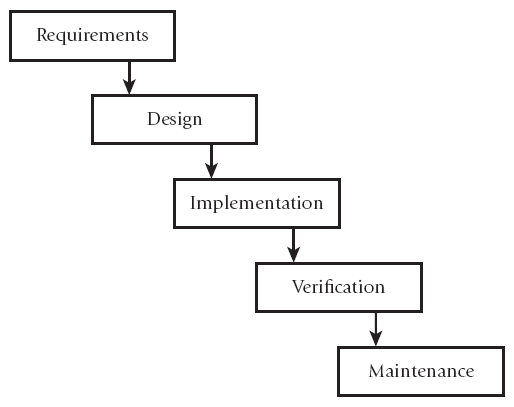
Figure 8.3 The waterfall model
Developed for use in the highly structured worlds of manufacturing and construction, the waterfall model has become a fairly standard model for projects in other fields, such as information technology, administration, education and healthcare. Every time you see a Gannt chart on a manager’s wall, you can be certain that the waterfall model is at work.
But is it effective?
Business projects are notoriously unsuccessful. Survey after survey reports that high proportions of projects fail to fulfil their brief, fail to deliver the promised return on investment and fail to add value to the business. And the reasons that they fail often have to do with the inability of the planning process to accommodate the wickedness of the problem.
It’s a question of context. The waterfall model may work in a closed system such as an assembly plant, where the problem parameters are closely defined. But if the context of the problem is more open, a neat linear progression from one stage to the next is unlikely to happen.
Wicked problems demand wicked planning.
When business intelligence projects lack intelligence
Most of the statistics about project management these days relate to information technology – sometimes called ‘business intelligence’, or BI.
A 2011 report by Gartner, an IT analyst, suggests that ‘between 70% to 80% of corporate business intelligence projects fail’. And the key reason, it seems, is that IT departments look at BI as an engineering problem rather than a business problem.
In other words, they are thinking ‘waterfall’ and ignoring the wickedness of the problem.
The first step, according to Patrick Meehan, president and research director in Gartner’s CIO Research group, is to find out what the business really needs: ‘If you don’t ask the right questions, BI is not a crystal ball that pops out the answer. People in IT need to stop approaching BI as a vendor or engineering solution, or as a tool. They need to understand what business they are in. They are in the information and communication business.’
Opportunity-led thinking
So, while the waterfall model can be put to good use within nice neat closed systems, it shouldn’t be used without careful thought about its effectiveness in your particular situation. For example, it doesn’t reflect the way we actually go about designing things.
Think back to making your design at the start of this chapter. Did you follow the waterfall model? How carefully did you consider the requirements of the task before beginning to design? How much did you design in your head before putting the pieces together?
My guess is that your thinking worked rather differently. You were negotiating in your mind between what you wanted to achieve, and what you could do. Whenever we’re creating something new, we have one eye on what we want to create, and another on what we have and what we can do (see Figure 8.4). The gap between the two creates a tension that we try to resolve by taking action.
Every need has a cost. Some needs will be more expensive to achieve than others; achieving more needs will probably cost more than achieving fewer needs. Designing a car that will protect its passengers in a 40mph head-on collision may cost more than designing a car that will protect its driver in a 30mph lateral collision. Successful design thinking is always a matter of balancing priorities: creating solutions that are new, feasible and cost-effective. It’s a tough combination to crack, but that’s what we’re trying to do.
The way to plan forwards is to look for opportunities to resolve the tension.
That’s not an analytical process. It’s not entirely rational. We’re looking for the combinations of elements that will balance all the priorities most effectively. And looking for combinations is as much intuitive as it is rational.
We know that if we try too hard to understand all the needs we’re trying to fulfil, we’re likely to get stuck. The technical term is ‘analysis paralysis’: we can’t take action until we have more information, but we can’t get more information until we take action.
To avoid analysis paralysis, try to find opportunities to create a solution. It’s called ‘opportunity-led’ thinking. Create possible solutions and see how they might work. Then adjust your search on the basis of what you find. All the time you’re looking for the places where you can make headway, backing up when an opportunity leads to a dead end, pushing forwards when it promises help.
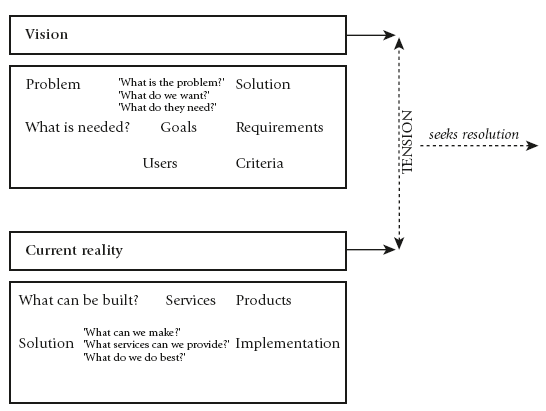
Figure 8.4 Vision and current reality
And if this reminds you of the intuitive problem-solving cycle we explored in Chapter 1 – well, that’s exactly what it is.
The resulting activity can look pretty chaotic (see Figure 8.5), but in fact it’s very well organized. You’re switching your focus of attention back and forth between your vision and current reality – between what you want and what you’ve got. You’re trying to make the most headway possible, regardless of where the headway happens, by making opportunity-led switches the focus of your attention.
Figure 8.5 Switching between vision and current reality
In design thinking, we need to be able to recognize a good solution when we stumble upon it.
Welcoming chaos into your project plans
Almost any project plan needs to include space for opportunity-led design thinking.
The waterfall model will work if – and only if – we’re solving a problem within a closed system. (Look back at Chapter 7, in particular the section on ‘modelling the problem system’.) If we can define the problem precisely, if we know precisely what the solution must look like and if we have the tools and experience to solve it – then a strictly linear plan, drawn up as a neat Gannt chart, will work.
Many problems, as we’ve seen, are wicked – the context of the problem is not closed but open and subject to change. The key factor in what makes a problem wicked is usually people. And people, on the whole, are pretty unpredictable. So if you’re designing a solution that involves users, customers or colleagues, then you’ll need to operate within a framework that can accommodate a degree of chaos.
Easier said than done, of course. Imagine you’re a project leader: you’re responsible for keeping the project to time and within budget. If the project fails to meet all the requirements in the brief, you’ll be accountable. You know that the process will – must – include opportunity-led thinking, but you must still make plans, create schedules and commit to milestones. Officially, you’re in charge of keeping the project on the waterfall line. It can be hard to loosen your control of a project and face the prospect of seemingly chaotic activity.
The key is to recognize when such thinking is necessary and to manage it dynamically. The control you need isn’t so much the control of a driver handling a machine, as the control of a surfer riding a wave. It’s the dynamic control that balances forces and looks always for the way forward.
From waterfalls to agility: how design thinking is evolving in software design
Software designers are acutely aware of the need to plan more effectively when creating solutions to wicked problems.
Creating a new piece of software to fit into an already existing system is nearly always a wicked problem. Users may not know exactly what they need before looking at a new piece of software. Software designers, on the other hand, can misunderstand users’ needs. The result can be software that fails to deliver on its potential or simply replicates what the old software did.
Agile Software Development was founded by a group of software developers in 2001 to address these problems. The Agile Manifesto, in its entirety, reads:
‘We are uncovering better ways of developing software by doing it and helping others do it. Through this work we have come to value:
- individuals and interactions over processes and tools
- working software over comprehensive documentation
- customer collaboration over contract negotiation
- responding to change over following a plan.’
This is as concise a description of good design thinking as you could get.
Putting design thinking to work every day
Design thinking is an increasingly vital skill. Unfortunately, it’s not a skill we’re much taught at school.
Edward de Bono, the inventor of – among other things – lateral thinking, has much to say on this subject. In an article for the Guardian in 1997, he claimed that ‘we prefer critical to constructive thinking, argument to design’. In part, he blames the influence of the ‘Gang of Three’: Socrates (‘who was mostly concerned with proving things wrong’), Plato (‘an arrogant Athenian authoritarian’) and Aristotle (‘with his word-based inclusion/exclusion logic’). According to de Bono, these three proclaimed that ‘knowledge is all’ and prioritized truth over what he calls ‘operacy’: ‘We are almost totally obsessed with “what is”. We underestimate the extremely valuable contribution that “what may be” has made to progress.’ As a result, our education system is systematically failing our young people. ‘The skills of action are every bit as important as the skills of knowing. We neglect them completely and turn out students who have little to contribute to society.’
De Bono may express himself in extreme terms, but he recognizes that design thinking is a vital element of problem-solving. ‘Most of the world’s major problems’, he writes, ‘will not be solved by yet more analysis and yet more information. We need to design ways forward.’
What to do
Improve your operacy skills
Here are 10 ideas that you could apply every day:
- Synthesize. Balance any analytical work you do with synthetic thinking. Look for connections, similarities and analogies. Seek methods of using information in new ways, and in new contexts.
- Learn how to learn (fast). Information overload is here to stay. Work out how you best create what you know. Schedule your knowledge work carefully so that you build in ‘absorption time’: naps, exercise, variation in types of work.
- Always have a long-term plan. Planning and design go hand in hand. Making a plan is always worth it, even if you change it every day. In fact, the best reason for making a plan is so that you can revise it. And learn more about the problem as you do so.
- Plan flexibly. Use backward planning: be clear about your goal when you are solving a problem. Recognize when your thinking is opportunity-led and allow time to explore.
- Map connections. Draw all your plans out on a large piece of paper; highlight the things that depend on other things. Find the things that don’t depend on anything but which have the most dependencies – and concentrate on them.
- Collaborate. One of the most important skills. Very few plans can be achieved by one person. You’ll need help, and you’ll need it often. Learn the skills of collaboration. Nurture your network of useful working relationships; you never know when you might need them.
- Make mistakes, and make them fast. You’re going to mess up; do it quickly and move on. Opportunity-led thinking is all about learning from experience; without having a go, you won’t learn. Try to make use of mistakes. To quote the great jazz guitarist, Joe Pass: ‘If you hit a wrong note, make it right by what you play afterwards.’
- Keep everything. Document what works. Write up protocols of best practice; keep early drafts; throw nothing away. If you don’t record it, it may never have an impact on the world. Much of creativity is learning how to see things properly. Most profound scientific discoveries are surprises. But if you don’t document and digest every observation and learn to trust your eyes, then you will not know when you have seen a surprise.
- Recycle. There’s only so much time and energy available for invention. If you can use what you created earlier, go ahead.
- Seek simplicity. If it looks hard to do, it probably is. Spend time looking for a dozen ways to make it simpler. You’ll save time later; it’ll work better; the world will be a better place for it. Albert Einstein was once asked why he used the same soap for washing and for shaving. His reply: ‘Two soaps? That’s too complicated.’
In brief
Plans: key features
- Problem statement: ‘How to ...’
- There is a gap between what is and what could be.
- Problem well defined: initial conditions, goal conditions, operators and constraints clear.
- Solution: create something new.
- Leading heuristics: ‘how to’; opportunity-led design.
Design thinking typically follows an iterative process:
- Express the problem as a ‘how to’ statement.
- Generate lots of ideas.
- Refine ideas and build feasibility.
- Repeat steps 2 and 3.
- Pick the winning solution and implement it.
We can develop the ‘how to’ operation by shifting our perspective in four directions:
- Shift upwards: if we achieve this, what larger problem do we solve?
- Shift downwards: how do we achieve this?
- Shift sideways: if we don’t achieve this, what problems do we face?
- Shift sideways: if we achieve this, what new problems do we create?
Most projects demand design thinking. Many project plans follow the waterfall model. This model works only when planning within closed systems. When the problem’s context is open, opportunity-led thinking is necessary.
Opportunity-led thinking seeks to resolve the gap between vision and reality: between what we want to create and our current resources, by looking for opportunities to act.
In design thinking we need to be able to recognize a good solution when we stumble upon it.
Many problems can be solved only with the skills of operacy.
